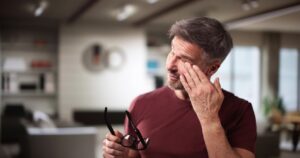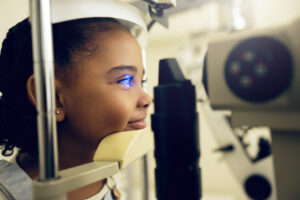In today’s digital age, it is nearly impossible to escape the glow of screens. Blue light from smartphones to laptops to tablets constantly surrounded us. But have you ever wondered about this blue light’s impact on your family’s vision? This blog will cover how blue light affects vision and proactive ways you can protect your family’s eyes and ensure each family member’s overall eye health and well-being in this digital era. The start of the year is an excellent time to prioritize your family’s eye health today. Let’s get started.
What is blue light, and where does it come from?
Blue light is a type of visible light with a shorter wavelength and higher energy than other colors in the visible light spectrum. Various sources, including natural and artificial sources, emit it. Here are some familiar sources of blue light:
- Sunlight: The sun is a natural source of blue light. Sunlight contains a broad spectrum of colors; blue light is a significant component of natural daylight.
- Digital Devices: Electronic devices such as smartphones, tablets, computers, and LED-backlit TVs emit blue light. The screens of these devices often use light-emitting diodes (LEDs), which emit a higher proportion of blue light.
- LED Lighting: Many modern lighting sources, including LED bulbs, also emit blue light. LED lighting is energy-efficient and widely used, but it can contribute to increased exposure to blue light.
- Fluorescent Lighting: Fluorescent light bulbs emit blue light, including compact fluorescent lamps (CFLs). Older generations of fluorescent lights emit more blue light than newer, energy-efficient models.
- Some Natural Sources: Some Natural Sources: Blue light is also present in natural sources such as candle flames and the blue sky.
The effects of blue light on vision
Digital devices have become an integral part of our daily lives, and the amount of time we spend in front of screens has significantly increased. The screens of these devices emit blue light, and prolonged exposure to this light can take a toll on our eyes. Intensely focusing on devices and being close to screens can result in eye strain and fatigue.
According to the Vision Council, the increase over the years in digital technology is leading to the rise in digital screen habits:
- Over 80 percent of adults report using digital devices for over two hours daily.
- Nearly 67 percent say they use two or more devices simultaneously.
- About 55 percent report looking at some screen in the first hour they are awake.
- Almost 80 percent say they use digital devices in the hour just before sleep.
Extended exposure to blue light can cause a range of eye problems. One of the most common issues associated with blue light is digital eye strain, also known as computer vision syndrome. Symptoms of digital eye strain include blurred vision, dry eyes, eye fatigue, and headaches. Prolonged exposure to blue light can lead to more severe conditions, such as macular degeneration, a leading cause of vision loss in older adults.
Blue light and sleep disruption
While exposure to natural blue light during the day is necessary for regulating our sleep-wake cycle and promoting alertness, extended or excessive exposure to blue light, especially during the evening and nighttime, can harm our vision and overall health.
The blue light emitted by screens can interfere with our natural sleep-wake cycle. Exposure to blue light in the evening and nighttime can suppress the production of melatonin, a hormone that regulates sleep. This exposure can result in difficulty falling asleep and disrupted sleep patterns.
Tips for reducing blue light exposure.
To reduce the impact of blue light from digital devices, take regular breaks and give your eyes a chance to rest. Additionally, adjusting your devices’ brightness and contrast settings can help reduce the intensity of the blue light emitted.
To minimize the impact of blue light on sleep, avoid screens at least one hour before bedtime. Instead, opt for activities that you find relaxing, like reading a book, listening to calming music, or practicing deep breathing exercises.
Blue light filters and glasses
In addition to taking breaks and adjusting screen settings, there are several other tips that can help reduce blue light exposure:
- Use blue light filters on your devices: Many devices now offer built-in settings that allow you to reduce the amount of blue light emitted. Enable these filters to automatically adjust the screen’s color temperature based on the time of day.
- Invest in blue light-blocking glasses: Blue light-blocking glasses are designed to filter out harmful blue light. They can be worn while using digital devices or even as regular eyewear to provide ongoing protection.
- Install blue light filter apps: Various apps can filter out blue light from your devices. You can install these apps on smartphones, tablets, and computers to reduce the amount of blue light reaching your eyes.
- Opt for warm light bulbs: Replace bright white or cool-toned LED lights with warm bulbs that emit less blue light.
- Make your bedroom a blue light-free zone: Remove electronic devices from your bedroom or ensure they are turned off or placed in night mode to minimize blue light exposure while you sleep.
When choosing blue light filters or glasses, look for those tested and proven to block a significant amount of blue light. High-quality filters and glasses will have a specific blue light protection rating, such as “blocks 90% of blue light.”
Natural ways to protect your eyes from blue light.
In addition to using blue light filters and glasses, there are natural ways to protect your eyes from blue light. These include:
- Eating a healthy diet: Consuming foods rich in antioxidants, such as leafy greens, berries, and fish, can help protect your eyes from damage caused by exposure to blue light.
- Taking regular eye breaks: Every 20 minutes, look away from your screen and focus on an object in the distance for at least 20 seconds. This exercise helps reduce eye strain and allows your eyes to relax.
- Practicing good posture: Proper posture while using digital devices can help prevent neck and eye strain. Sit straight, keep the screen at eye level, and avoid slouching or leaning forward..
Blue light and children’s vision

Children are especially vulnerable to the effects of blue light due to their developing eyes. Increased screen exposure at a young age can contribute to digital eye strain, dry eyes, and other vision problems.
To protect children’s eyes from blue light, set limits on screen time and encourage a healthy balance between digital activities and other forms of play. Consider implementing screen-free zones or designated screen-free times during the day.
Blue light and aging eyes

As we age, our eyes become more susceptible to damage from blue light. The natural aging process and prolonged exposure to screens can increase the risk of developing age-related eye conditions such as macular degeneration.
Regular eye exams are essential for detecting and managing any age-related eye conditions. Additionally, following the tips mentioned earlier, such as using blue light filters and practicing good posture, can help protect aging eyes from the harmful effects of blue light.
Conclusion: safeguarding your family’s eyes from blue light
Protecting your family’s eyes from the harmful effects of blue light is crucial in the digital age. Measures such as using blue light-blocking glasses, promoting healthy screen habits, incorporating technological solutions, and adopting natural approaches can safeguard eye health. Special attention is needed for children and aging individuals, emphasizing the importance of limiting screen time and regular eye check-ups. Prioritizing these protective measures ensures the well-being of your family’s vision in the face of constant screen exposure. Contact us today for your personalized consultation at Alice Family Eye Center for protecting your eyes from blue light.
Happy New Year!





